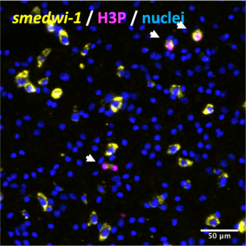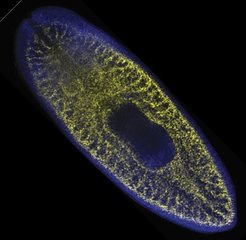Stem Cell Dynamics

Dissociated cell preparation, stained for smedwi-1 mRNA (stem cell marker), phosphor-histone H3 (mitosis marker) and DAPI (nuclei).
Planarians have a unique and fascinating stem cell system made up of pluripotent adult stem cells. These so-called “Neoblasts” are the only division-competent cells in the worms and depending on the markers used, they comprise as much as 10- and 30 % of all cells. Feeding or wounding stimulates neoblast divisions, which generate a pulse of postmitotic progenitor cells for growth or regeneration. Neoblasts also divide at a basal rate in starving or non-regenerating animals and the resulting progeny continuously replaces dying differentiated cells, including the neurons of the brain. The result is a uniquely dynamic tissue architecture, which involves the continuous turn-over of all organismal cell types and the capability of restoring planarian body plan anatomy even after catastrophic injuries.
The pivotal role of neoblasts in maintaining and regenerating the planarian body plan makes them a natural focus of departmental research objectives and a source of many intriguing questions. Ongoing projects address the mechanisms of neoblast activation by feeding and wounding, how the system-wide balance between self-renewal and differentiation is maintained and how the organism-wide signaling gradients contribute to making the right cells at the right place. We also probe the systems responses to genetic heterogeneity in chimeras between genetically distinct donor strains and we decisively develop the tools required for a quantitative understanding of stem cell systems dynamics, including live-imaging (Boothe et al. 2017, Weigert et al. 2018), transgenic lineage tracing and in vitro neoblast cell cultures towards the far goal of differentiating and entire animal out of a stem cell culture.
Questions we are interested in

Whole-mount visualization of Neoblasts in a planarian (smedwi-1 mRNA; yellow). Image credit: Dr. Hanh Vu.
In general, the role of pluripotent adult stem cells as sole source of new cells in planarians raises many fundamental and intriguing problems, including for example:
- Which principles and mechanisms govern the cell fate choices of neoblast progeny while navigating the sheer complexity of the adult organismal cell lineage tree?
- How do planarians manage to match supply and demand for specific progenitor cell types at steady state, during injury recovery or growth/degrowth?
- What are the mechanisms that guide the cell migration of progenitors to their target organs?
- How do planarians deal with the potential for genetic drift amongst the pluripotent stem cells?
- What are the evolutionary and gene regulatory homologies between neoblasts and stem- or germ cells in other organisms?
Live-imaging of a nuclear marker over 6 hours, providing first glimpses of planarian tissue dynamics.

